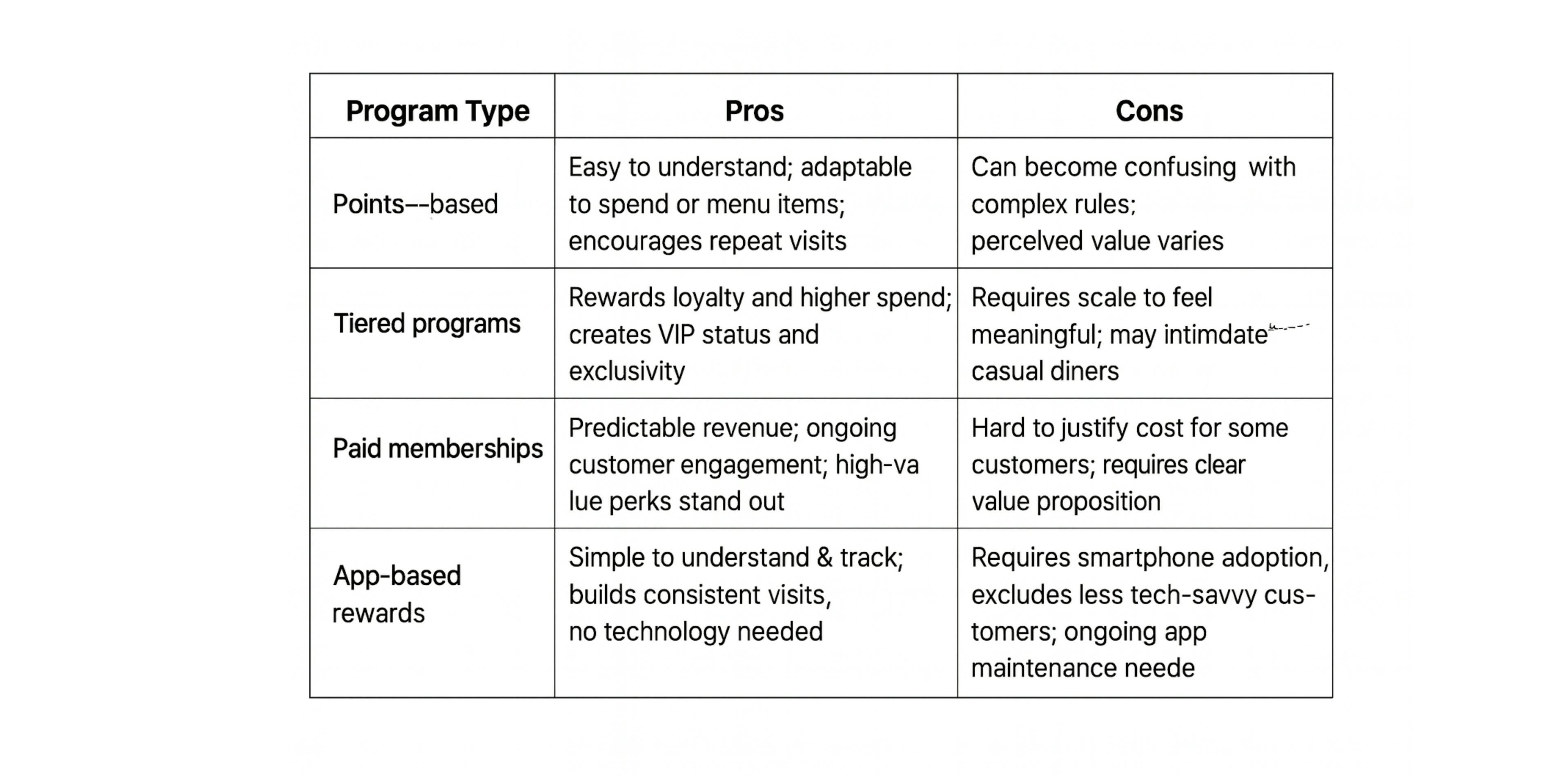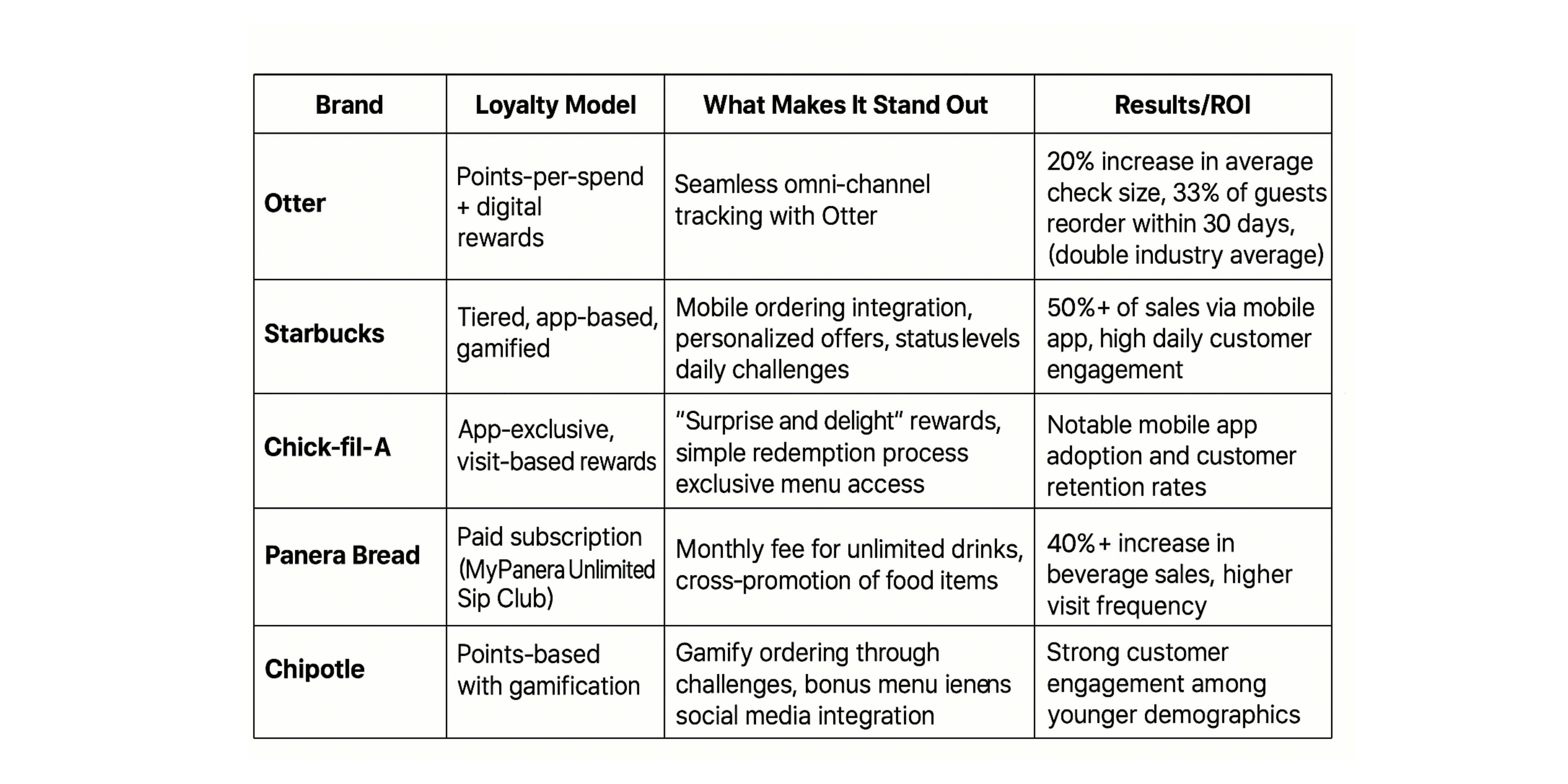
Table of contents
- Why loyalty programs still matter (and deliver)
- Points, perks, and punch cards: exploring loyalty program formats
- What makes a loyalty program successful?
- Using customer data to personalize and optimize
- How to build a loyalty program your guests actually love
- Successful restaurant loyalty programs you can learn from
A 5% increase in customer retention can boost restaurant profits by up to 95%—yet most restaurants still struggle to keep diners coming back [1]. Meanwhile, Accenture's global loyalty study found that, when compared to non-members, rewards program members generate significantly more annual revenue for businesses, spending more per visit and ordering more frequently [2].
With rising food costs and intensifying competition in the restaurant industry, retaining loyal customers has never been more necessary. No longer can restaurant brands rely on simple punch card systems. Now, restaurant owners are embracing personalized, data-driven customer loyalty programs that deliver targeted special offers through mobile apps and POS integration.
This article explores different types of restaurant loyalty programs, what makes them successful, and how modern tools help capture valuable customer data to drive repeat visits. We'll examine real-world examples from leading restaurant brands, share key success factors, and provide a step-by-step action plan for designing a rewards program that enhances customer experience and builds genuine brand loyalty.
Whether you operate a single location or multiple restaurant brands, it’s now a necessity to learn how to leverage customer data to strengthen loyalty. Why? Simply put, it’s one of the most effective marketing strategies for increasing customer lifetime value.
Why loyalty programs still matter (and deliver)
For restaurant owners, few marketing strategies deliver the long-term impact of a well-designed customer loyalty program. Loyal customers drive repeat business, spend more per visit, and are more likely to try new menu items. In short, repeat diners become your restaurant brand’s advocates, influencing others to engage through social media and word-of-mouth recommendations.
Deloitte's Restaurant Loyalty Programs study reveals that nearly half of loyalty program members (47%) use their membership several times monthly, while one in three (32%) engage multiple times each week [3]. This level of customer engagement demonstrates how effective rewards programs meaningfully increase visit frequency and customer lifetime value without the high costs that come with new customer acquisition.
Many leading restaurant brands have long embraced data-driven loyalty strategies. Starbucks, for example, uses gamification and mobile app challenges that encourage rewards members to interact daily with the brand, while Chick-fil-A offers in-app exclusive offers to deepen customer relationships and boost average order values. These successful loyalty programs prove that effective customer retention doesn't require massive budgets or complex systems.
Independent restaurant owners can achieve similar results by offering programs that are easy to join, deliver clear and attainable perks, and consistently reward repeat visits. The key lies in understanding your customer base and designing rewards that enhance their dining experience while supporting your business goals.
Points, perks, and punch cards: exploring loyalty program formats
Points, perks, and punch cards: exploring loyalty program formats

Quick Format Examples
Amount-based points: Earn 10 loyalty points per $1 spent. Incentivizes larger orders and higher customer spending.
Tiered membership: Silver, Gold, Platinum levels. Unlock better perks like free appetizers and exclusive menu access with higher engagement.
Subscription perks: Unlimited drinks club (like Panera's MyPanera). Immediate value for frequent customers.
Choosing the Right Fit
The right choice depends on your menu offerings, profit margins, and customer behavior patterns. Start with a model that's easy to manage and understand, then expand or customize as customer data and feedback accumulate.
If you're unsure which format to launch, a simple points-for-spend model paired with digital tracking often proves most familiar and effective for restaurant marketing. As your program gains traction with loyal customers, you can evolve toward tiered systems or hybrid concepts that better fit your specific goals and customer base.
What makes a loyalty program successful?
A winning restaurant loyalty program balances genuine value for customers with simplicity and clear benefits for the business. Here are the core success factors restaurant owners and managers should prioritize:
Easy Sign-Up & User Experience
The less friction during enrollment, the higher the participation rates. Customers should be able to join quickly via QR codes, mobile apps, receipt links, or in-store signup with minimal information required. The fewer steps that exist between interest and membership, the more your first-time visitors will convert to rewards members.
Valuable and Attainable Rewards
Rewards must be both desirable and realistically achievable. If customers perceive freebies as too difficult to earn, they'll lose interest quickly. Offer compelling options like free food, bonus points, or special offers after a modest number of qualifying purchases. The prize needs to feel worthwhile to diners without threatening your profit margins.
Clear Communication
Outline exactly how your program works: how to earn, track, and redeem loyalty points. Use in-store signage, staff training, notifications, and digital channels to keep customers informed and motivated. Alert members when they're close to earning rewards, or highlight new menu items that offer bonus points.
Seamless Tech Integration
The best loyalty programs connect smoothly with your POS system, online ordering platform, and mobile app. This enables instant tracking, personalized offers, and consistent customer experience no matter how the customers orders—pickup, takeout, or dine in-store. Integration also reduces staff workload and improves reward accuracy.
Fits Your Goals and Margins
Every successful loyalty program should align with your restaurant's unique objectives, whether you’re looking to increase visit frequency, drive larger order values, promote new food items, or all of the above. Set your points-to-dollar ratios and reward thresholds to motivate profitable behaviors, not just repeat discounts (as this can erode margins).
Drive Larger Orders and Menu Discovery
Design your program structure to encourage customers to boost their average spend or try new offerings. Examples include "Bonus points for ordering chef's specials" or "Free drink with orders over $30." This keeps your program exciting for customers while supporting your bottom line.
Consistent Promotion and In-Store Visibility
Don't let your loyalty program become an afterthought. Feature it prominently on table tents, menus, receipts, at registers, and across all digital touchpoints. Train staff to mention the program during every customer interaction. A rewards program only works if customers know about it and remember to use it.
The Best Program Is One Customers Actually Use
Ultimately, the most effective restaurant loyalty program is one that customers understand and enjoy using regularly. Simplicity, transparency, and consistent messaging build trust and habits. While technology removes friction and provides valuable customer data, the foundation of customer loyalty remains delivering an exceptional dining experience every single visit.
By combining these elements, your loyalty program will become a powerful engine for higher order values, increased repeat visits, and stronger brand loyalty over time.
Using customer data to personalize and optimize

Modern restaurant loyalty programs go far beyond simple point tracking. In today’s world, they serve as sophisticated engines for personalized customer engagement. By capturing and analyzing customer data, leading restaurants create targeted experiences that drive repeat business and deepen customer relationships.
What Data Do Loyalty Programs Capture?
Effective loyalty platforms gather diverse customer information:
Identity and preferences: Name, email, birthday, contact preferences, and dietary restrictions captured at signup.
Purchase history: What customers buy, when they visit, order frequency, and spending patterns, which aid in creating detailed profiles of individual tastes and habits.
Engagement analytics: Every interaction including mobile app usage, online ordering behavior, reward redemptions, and participation in promotional campaigns.
Behavioral insights: Peak dining times, preferred locations, average order values, and response rates to special offers.
Turning Data into Action
The real power lies in transforming this customer data into meaningful, personalized experiences:
Targeted Offers: Use purchase history to send customers personalized offers on their favorite menu items, birthday rewards, or "just for you" incentives.
Reactivation Campaigns: Automatically identify customers who haven't visited recently (30+ days) and trigger "We miss you" promotions with free appetizers or exclusive offers.
Smart Recommendations: Advanced platforms suggest complementary food items based on previous orders, increasing both customer delight and average check value through relevant upselling.
Customer Segmentation: Analytics tools allow restaurants to segment customers by behavior—frequent lunch buyers versus weekend family diners—and send each group offers most likely to drive repeat visits.
Predictive Analytics and Automation
Technology-driven loyalty programs enable proactive customer engagement:
Predictive Modeling: Machine learning identifies which customers are likely to lapse, who are prime candidates for upselling, or which special offers will convert best—helping focus marketing spend for maximum ROI.
Real-Time Personalization: Systems can adjust promotions based on weather, time of day, or customer segment, automatically optimizing the customer experience to drive both online ordering and in-store visits.
Automated Notifications: Send timely alerts about reward availability, new menu items, or limited-time offers when customers are most likely to respond.
Accessible to All Restaurant Brands
While major chains like Starbucks, Panera, and Chipotle leverage sophisticated customer data strategies across thousands of locations, independent restaurants can access similar capabilities through affordable loyalty solutions. The key is starting with integrated systems that connect POS data, online orders, and mobile app activity, then building segmentation and personalization as customer data grows.
By leveraging customer data for targeted engagement, restaurants of any size can transform casual diners into devoted brand advocates.
How to build a loyalty program your guests actually love
Creating an effective restaurant loyalty program requires strategic planning, the right technology, and thoughtful execution. Here's a practical action plan for launching a rewards program that delivers results for both your restaurant and your customers:
1. Define Clear Goals and Success Metrics
Decide what you want to achieve: more repeat visits, higher average order values, faster adoption of new menu items, or increased customer retention. Establish key performance indicators like enrollment numbers, repeat visit rates, average spend per loyalty program members, and reward redemption rates.
2. Choose the Right Program Format
Select the loyalty model that fits your brand and customer base, like points-based systems, tiered memberships, subscription perks, or hybrid approaches. Ensure your rewards structure is simple to understand and offers compelling value without compromising profit margins.
3. Identify and Collect Key Customer Data
Plan to capture essential information including email, phone numbers, and purchase history so you can deliver personalized offers over time. Ensure your technology platform and staff can gather this customer data seamlessly during the signup process.
4. Set Rewards and Margins Carefully
Determine which rewards provide genuine value—free food, bonus points, exclusive offers, or special access—while remaining profitable for your business. Offer meaningful perks at attainable thresholds, but always verify that reward costs align with your financial goals.
5. Choose the Right Technology Partner
Select a loyalty solution that integrates smoothly with your POS system, online ordering platform, and mobile app. Consider platforms like Otter that provide frictionless management, real-time analytics, and automated customer engagement tools to maximize program effectiveness.
6. Train Your Team for Success
Ensure all staff understand how the program works. Make sure they can enroll new customers confidently while answering basic questions about earning and redeeming rewards. Provide simple scripts for in-store signup processes and reward explanations.
7. Promote Across All Channels
Launch your program with comprehensive promotion: in-store signage, social media campaigns, email announcements, receipt mentions, and menu inserts. Use limited-time signup incentives like free appetizers or bonus points to create momentum and encourage first-time enrollments.
8. Measure, Adjust, and Grow
Monitor participation rates, customer engagement levels, and program ROI regularly. Track what works and what doesn't, gathering feedback from both customers and staff. Experiment! Try new reward ideas or adjust point values based on real customer behavior and preferences.
Celebrate program milestones with your team and showcase achievements like reaching your 1,000th member to maintain enthusiasm and demonstrate success.
9. Start Simple, Grow Smarter
The most successful loyalty programs begin with straightforward concepts and evolve based on customer data and feedback. Don't wait for perfection. Just launch your program, track your results, and commit to continuous improvement. The sooner you start building customer loyalty, the sooner you'll see measurable impact on repeat business and customer lifetime value.
If you're ready to get started, solutions like Otter can streamline every step—from initial setup to ongoing analytics—so you can focus on creating exceptional dining experiences for your regulars.
Successful restaurant loyalty programs you can learn from
Real-world examples demonstrate how diverse restaurant brands use loyalty programs to drive measurable results. From global chains to independent operators, these case studies showcase different approaches to building customer engagement and increasing repeat business.
Leading Restaurant Loyalty Programs

Otter Loyalty Results Spotlight
Restaurants using Otter's loyalty platform consistently achieve impressive results across key performance metrics. Data from multiple locations shows that loyalty program members generate significantly higher value:
- Average check increases: Restaurants see up to 20% increases in average order value within 90 days of launching their loyalty program
- Repeat order frequency: Nearly 1 in 3 loyalty members reorder within 30 days, double the rate of non-members
- Faster reorder cycles: Loyalty members return 7% earlier than non-members, which translates to approximately 6 additional days of ordering frequency over a 3-month period
These results demonstrate how data-driven loyalty programs create measurable impact on both customer behavior and restaurant revenue, regardless of restaurant size or concept.
Key Success Patterns
Mobile-First Approach: Leading restaurant brands prioritize mobile app experiences that integrate seamlessly with online ordering and in-store purchases. This creates consistent customer experiences across all touchpoints while capturing valuable customer data.
Personalization at Scale: Successful programs use purchase history and customer preferences to deliver targeted special offers, birthday rewards, and menu recommendations that feel relevant rather than generic.
Gamification Elements: Top-performing loyalty programs incorporate game-like features—challenges, bonus point opportunities, and achievement levels—that keep customers engaged between visits and encourage experimentation with new food items.
Clear Value Proposition: Whether through free drinks, exclusive menu access, or surprise rewards, the best loyalty programs communicate their benefits clearly and deliver consistent value that customers can easily understand and appreciate.
Lessons for Independent Restaurants
These examples prove that effective customer loyalty programs don't require massive budgets or complex technology. The core principles—seamless signup, valuable rewards, consistent communication, and data-driven personalization—apply equally to single-location restaurants and major chains.
- Start with the basics: Focus on easy enrollment, clear reward structures, and reliable redemption processes before adding advanced features like tiered memberships or subscription models.
- Leverage available technology: Modern POS systems and loyalty platforms like Otter enable even small restaurants to access sophisticated customer data analytics and automated marketing tools previously available only to large restaurant brands.
- Build gradually: Begin with simple points-based rewards, then expand to include personalized offers, automated notifications, and targeted promotions as your customer base and data collection capabilities grow.
By studying these successful examples and adapting their strategies to your unique customer base and business goals, you can create a loyalty program that drives meaningful results regardless of your restaurant's size or concept.

Book a demo with Otter
It’s time to enhance your operations with Otter’s all-in-one restaurant platform. Book time with our sales team to learn more.

Book a demo to see how Otter’s all-in-one platform can help your restaurant thrive.